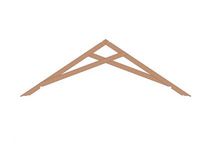RTC
Member
There doesn't seem to be an Introductions section, so I will use this section to do so.
I'm not a 'real' woodworker I'm afraid. I'm an inveterate car tinkerer and more comfortable with a length of 40x40x3 RHS* steel and a MIG welder than 50x100 softwood and a plane. I’ve reached 59¾ (and I'm staying there) and benefit from early retirement so it’s finally time to rebuild that Jaguar that has been waiting for me.
Unfortunately my sons share my car tinkering interest and we now have 8 vehicles between the 4 of us – 3 of which are long term ‘projects’. The youngest vehicle in our family fleet is rapidly approaching its 10th birthday, my existing double garage has its own entity on Google Calendar and I never seem to be able to book a long enough ‘slot’ in it for my own project car!
So, having consulted SWMBO, completed her kitchen, utility room and 2 of the 3 bathroom refurbishments, I now have permission to plan another Garage/Workshop/Man-Cave exclusively for my own use (as if!). Getting permission to budget for it is a debate for another day!
I’ve been playing about with SketchUp and after many drafts over many months I have decided on the general arrangement of my Project.
I will post details of the general design – but it will not be another incredible Gambrel Roof trainee luxury retirement cottage with lots of beautiful and elegant detailing!
To date I have used SketchUp just to draw ‘chamfered boxes’ to give SWMBO a general impression of the various alternative styles, play with the limitations of Permitted Development, check shadow casting, vehicle accessibility etc. Now I’m getting down to actually designing the thing, I find my SketchUp skills leave much to be desired.
I’m almost cross-eyed from reading all the information I’ve downloaded from the Wibbly Wobbly Web. I’ve lost track of what I read where. I've worn out a calculator and my memory converting US Imperial Units to more comprehensible SI Units. Finally, to round of my exploration of a new subject I find plenty of conflicting information - what a surprise!
So I’m afraid I’ll be asking lots of questions that you may have seen before. I promise I will study the Build threads I have already read as a guest. I hope you will be as generous with your time and knowledge as I have seen others benefit from already.
Bob.
*Rectangular Hollow Section
I'm not a 'real' woodworker I'm afraid. I'm an inveterate car tinkerer and more comfortable with a length of 40x40x3 RHS* steel and a MIG welder than 50x100 softwood and a plane. I’ve reached 59¾ (and I'm staying there) and benefit from early retirement so it’s finally time to rebuild that Jaguar that has been waiting for me.
Unfortunately my sons share my car tinkering interest and we now have 8 vehicles between the 4 of us – 3 of which are long term ‘projects’. The youngest vehicle in our family fleet is rapidly approaching its 10th birthday, my existing double garage has its own entity on Google Calendar and I never seem to be able to book a long enough ‘slot’ in it for my own project car!
So, having consulted SWMBO, completed her kitchen, utility room and 2 of the 3 bathroom refurbishments, I now have permission to plan another Garage/Workshop/Man-Cave exclusively for my own use (as if!). Getting permission to budget for it is a debate for another day!
I’ve been playing about with SketchUp and after many drafts over many months I have decided on the general arrangement of my Project.
I will post details of the general design – but it will not be another incredible Gambrel Roof trainee luxury retirement cottage with lots of beautiful and elegant detailing!
To date I have used SketchUp just to draw ‘chamfered boxes’ to give SWMBO a general impression of the various alternative styles, play with the limitations of Permitted Development, check shadow casting, vehicle accessibility etc. Now I’m getting down to actually designing the thing, I find my SketchUp skills leave much to be desired.
I’m almost cross-eyed from reading all the information I’ve downloaded from the Wibbly Wobbly Web. I’ve lost track of what I read where. I've worn out a calculator and my memory converting US Imperial Units to more comprehensible SI Units. Finally, to round of my exploration of a new subject I find plenty of conflicting information - what a surprise!
So I’m afraid I’ll be asking lots of questions that you may have seen before. I promise I will study the Build threads I have already read as a guest. I hope you will be as generous with your time and knowledge as I have seen others benefit from already.
Bob.
*Rectangular Hollow Section







